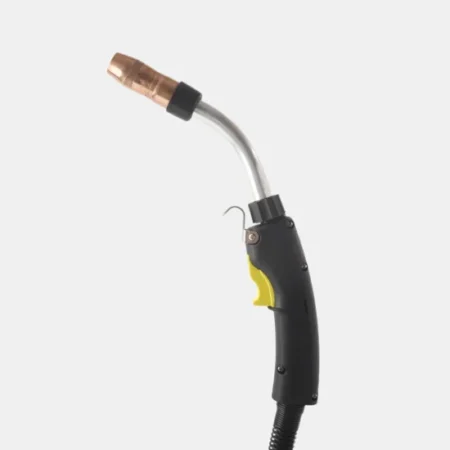Table of Contents
ToggleDifferent Types of Welding Torches Explained
When sparks fly, it’s not just metal fusing together—it’s the connection between the welder and the torch. A welding torch is more than a tool; it’s an extension of the welder’s skill and precision. With various types available, understanding their features and benefits helps customers choose the right one. This article explores different types of welding torches, their applications, and key advantages to support informed purchasing decisions. I have categorized them as follows:
1. MIG Welding Torch:
The Metal Inert Gas (MIG) welding torch, also known as a GMAW torch, offers unparalleled speed and efficiency. It uses a consumable wire electrode and a shielding gas to protect the weld from contamination. This torch type is popular in industries requiring high productivity, such as automotive manufacturing, shipbuilding, and general fabrication.
Selecting the right MIG welding torch involves understanding several crucial factors to ensure optimal performance and operator comfort. One key factor is the duty cycle, which measures the torch’s ability to operate continuously without overheating. For example, the Bernard Q40 MIG GUN, which has a 60% duty cycle, allows for 6 minutes of continuous welding at full capacity within a 10-minute period.
Moreover, the higher amperage of a MIG welding torch typically results in increased weight, impacting user comfort and efficiency during extended operations. For example, the Bernard Q40 MIG gun (15ft) weighs approximately 5kg, so a well-designed torch is important for comfort. A contoured handle provides a secure grip, a responsive trigger allows precise control, and a well-balanced gun body makes handling easier. Flexible cables also improve movement, helping welders work smoothly and accurately.

2. TIG Welding Torch:
Next on our list is the Tungsten Inert Gas (TIG) welding torch. Known for its precision and clean welds, the TIG torch uses a non-consumable tungsten electrode to create an arc, argon as a shielding gas to protect the weld, and often a separate filler rod to add material to the weld pool. Welders gain greater control over the welding process with the TIG torch, making it ideal for delicate and precise welding tasks like aerospace fabrication, automotive restoration, and pipe welding.
Morever,the TIG welding torch handle is crafted from advanced polymers and composites, offering durability and lightweight comfort. These materials ensure heat resistance and reduce wear, while a textured grip enhances control and precision.

Unlike other torches that primarily use copper nozzles, TIG torches often employ ceramic nozzles which offer superior resistance to heat and spatter. This material choice ensures durability and consistency in welding performance, especially at high temperatures.

3. Oxy-Fuel Welding Torch:
One of the oldest types of welding torches is the oxy-fuel torch, which combines oxygen and a fuel gas, typically acetylene. This torch type enables superb versatility, making it suitable for many applications, including metal cutting, brazing, and welding. With the oxy-fuel welding torch, customers can easily join metals, making it an ideal tool for construction, automotive repairs, and plumbing.

What are three advantages to oxyacetylene welding?
- Adjustable Flame: The ability to control both the flame size and heat output makes it highly adaptable for a wide range of welding tasks, offering precision for delicate work.
- Wide Applicability: It can weld, cut, and braze a variety of materials including steel, cast iron, copper, brass, and aluminum, making it suitable for a diverse range of projects.
- No Power Supply Needed: Since the torch operates entirely with gas, it is useful in environments where electrical power may be limited or unavailable, such as remote job sites or outdoor applications.
And Disadvantages:
- Slower Welding Speed: Oxy-Fuel welding can be slower, particularly on thicker materials, due to its lower heat intensity compared to modern methods.
- Gas Costs: Although the equipment itself is inexpensive, purchasing and storing the necessary gases (acetylene, oxygen) can incur ongoing costs, especially with frequent use.
- Safety Risks: Handling high temperatures and combustible gases presents safety risks, such as flashbacks or explosions, if proper procedures are not followed.

4. Plasma Cutting Torch:
While primarily used for cutting, the plasma cutting torch deserves a mention due to its role in the welding process. Plasma torches utilize a high-temperature jet of ionized gas to cut through conductive materials. Apart from cutting, these torches are valuable for gouging, metal removal, and even precision welding applications. They find extensive usage in industries like metal fabrication, construction, and heavy equipment manufacturing.

5. Submerged Arc Welding Torch:
Submerged Arc Welding (SAW) torches find their niche in heavy-duty welding operations, particularly those involving thick materials. In this torch type, a granular flux blankets the weld area, creating a protective shield. Submerged arc welding torches excel in applications such as pipeline welding, pressure vessel fabrication, and structural steelwork, thanks to their high deposition rates and ease of automation.
 SOURCE:MILLER OBT 600 SubArc Torch
SOURCE:MILLER OBT 600 SubArc Torch
6. Robotic Welding Torches:
Robotic welding torches are at the forefront of modern welding technology, designed to work seamlessly with automated systems. These torches offer unparalleled precision and efficiency, ideal for repetitive tasks in large-scale manufacturing. Equipped with advanced sensors and control systems, robotic welding torches ensure consistent weld quality while reducing human error and labor costs. Whether in automotive or aerospace industries, these torches are essential for achieving high-quality, scalable welding solutions in automated environments.
Conclusion:
Investing in the right welding torch is crucial for achieving optimal performance and high-quality welds. As we explored the different types of welding torches, we highlighted their specific applications and benefits. Whether customers require versatility, precision, speed, or automation, there is a welding torch to meet their needs. By understanding the diverse range of torches available, customers can confidently select the appropriate welding torch for their projects, ensuring remarkable results every time.

